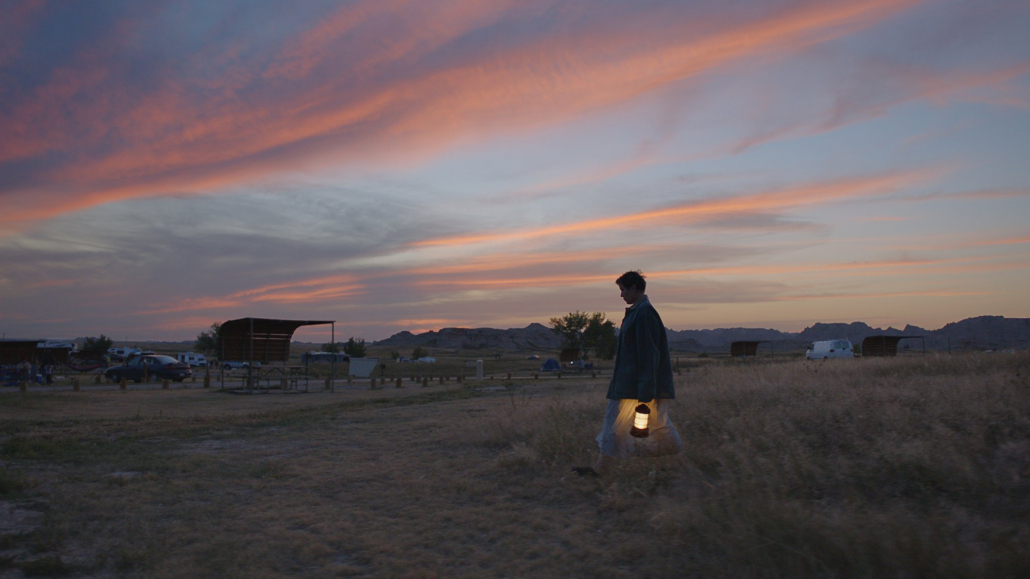REVIEW: “Nomadland” lingers in places of the mind, heart and soul

This review contains spoilers.
Written and directed by Chloé Zhao and adapted from the 2017 nonfiction work “Nomadland: Surviving America in the Twenty-First Century,” “Nomadland” is like its namesake — it toes the line between two spaces and genres, never settling in one. Ultimately, the film chooses to inhabit a distinctly poetic home at the nexus of documentary and drama. This unique intersection is given new meaning in “Nomadland,” where real-life nomads star as themselves.
“Nomadland” balances a sweeping aesthetic vision with the more grounded reminders: this story isn’t meant to provide a rosy venture into the benefits of nomadic living; instead, it’s a glance at what it means to leave places and the people who take such ventures.
The film begins by introducing Fern, played by two-time Academy Award winner Frances McDormand, a widow who loses her job at the U.S. Gypsum plant in Empire, Nevada. She wanders from place to place afterward — working at an Amazon warehouse, to living in a gathering place for “nomads:” others like her who live out of trailers and on the road. The story follows Fern as she traverses across landscapes and meets new people, cycling back to the Amazon warehouse, harvesting beets at another job and leaving permanence before it gets too close to her.
Close ups of Fern in her van are juxtaposed with the moving scenery behind her. Voiceover dialogue takes place simultaneously over footage of landscapes. It’s a jarring kind of reality and loss that feels like a haunting of a space; a gritty reimagining of land affirming its human connection. There’s also quiet, more reflective undertones in the stories that these nomads share as they sit around the campfire, about their lives before they lost their jobs and their family members and became the people who found homes in “houselessness.”
Poetic shots of Fern’s solitary figure are paralleled with her interactions with others. One relationship of significance is between Fern and Swankie, a fellow nomad whose brashness and strong personality make her easily the most unforgettable character in the film.
When Swankie dies toward the end, the product of a long-term battle with cancer, the nomads host a campfire to commemorate her life. As the nomads pay respect to their former friend, the sparks from the campfire rise into the night, a visual allusion to these lives fading into the U.S. landscape and a greater, larger unknown.
As Fern progresses in her journey into this unknown, a melancholic tone permeates the cinematography, contrasted with the sounds and images that are distinctly part of the story. We see the clothes cycling through a washing machine at a laundromat. We hear the nomads singing together, a reminder that there’s a temporary home to be found even in the most transient of places.
The somber music that floats throughout the film conveys Fern’s own grief at losing her husband. Despite the fact that Fern constantly travels from one place to another, Zhao’s portrayal of Fern often feels stagnant, as if there’s still one place that Fern can’t ever leave no matter how much she moves.
Perhaps that’s what grief is, and in that regard, “Nomadland” is full of grief. It feels like a meditation on the memories that weigh us down even as we separate ourselves from the places where they were formed.
In addition, wider discussions of the dichotomy between a mere road trip and a life on the road invite the audience to consider the intent behind living. The distinction between the life of the nomad and those who participate in the nomadic life temporarily illustrate the importance of circumstance in determining whether loneliness is artificially or authentically constructed. McDormand’s performance shines in the latter, as her distant expressions imply not only her distance from others, but also the audience.
“Nomadland” does feel slow-paced at times, dragging its feet in the stunning cinematography. However, the pacing indicates that this narrative is purposefully meant to mimic the lifestyle of the nomads who drift from place to place. It’s hard not to feel overwhelmed by the seeming emptiness of Fern’s life at times, but the emphasis is on the details. It’s the small elements, the sloshing of a coffee thermos or the echo in a canyon, that remind us Fern’s life defines a kind of home in and of itself.
There are so many goodbyes in “Nomadland” that it feels like the story first and foremost pays homage to the absences in life. What’s most memorable about the film, however, is that it takes the time to acknowledge the presences as well — the presences of community, small moments of joy and humanity in a wider economic recession.
Fellow nomad Bob describes the nomadic life best: “One of the things I love most about this life is that there’s no final goodbye … I always just say, ‘I’ll see you down the road,’ and I do. And whether it’s a month or a year, sometimes years, I see them again.” It’s a beautiful reminder that even the goodbyes themselves aren’t permanent, nor the places that created them.
As far as storylines go, “Nomadland” wanders aimlessly, much like its central character. Yet in the moments where it needs to, it pauses to evoke a nostalgia in its audience for a bare, American life. It cherishes the bits of freedom and agency found in a raw kind of realness. It stops, and lingers.

